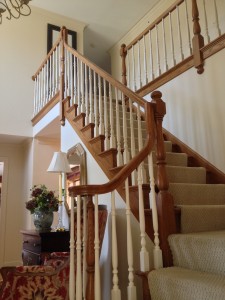As painting and decorating contractors in the Chicago area, we are often asked if we could paint the spindles in a wood staircase. Almost always, it is the lady of the house asking this question. Women are often less found of the “Wood Look” than men. Painting only the spindles can be not only a good compromise between the two spouses, but also a smart design touch.
Just painting spindles on a wood staircase is a labor-intensive endeavor. To do a quality job, there cannot be any paint on surfaces other than the spindles. To accomplish that result, we have to tape off the steps around the bottom of the spindles and sometime the top as well. Next we scuff-sand the spindles and then apply one coat of bonding primer to ensure a good adhesion to the old finish. The spindles then receive two coats of waterborne enamel. After adequate dry-time, the tape is removed, along with any paint residue. To be efficient and to produce the best result, two people should simultaneously do the priming and painting steps.
Keeping the peace in the household about the “wood look” by painting spindles is not only a smart idea, but also a good design choice as well, as shown in our picture








 Follow
Follow






